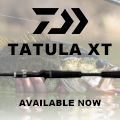type of wood for swimbaits?
type of wood for swimbaits?
i have been making swim baits for about 4 mouths i have a design that i am pretty happy with it has great motion just one problem though. i need help with wood selection i hear from many people what to use this and that and i need some more opinions.
<a href="http://s153.photobucket.com/albums/s204 ... chment.jpg" target="_blank"><img src="http://i153.photobucket.com/albums/s204 ... chment.jpg" border="0" alt="Photobucket"></a>
<a href="http://s153.photobucket.com/albums/s204 ... chment.jpg" target="_blank"><img src="http://i153.photobucket.com/albums/s204 ... chment.jpg" border="0" alt="Photobucket"></a>
- Dynastyworms
- Posts: 588
- Joined: Thu Mar 23, 2006 11:46 pm
- Location: The Great State of Arizona
-
reellittlephish
- Posts: 80
- Joined: Fri Dec 09, 2005 7:52 pm
- Location: Las Vegas, Nevada
Re: type of wood for swimbaits?
I started making wooden swim baits back when I saw the first Alan Cole AC plugs. And I am a career woodworker/ cabinetmaker. So much for some authority on the subject. I used to fish Lake Skinner and used a "Louie Lure" with great success. Those were hand made by a local and reminiscent of a "J" plug..
The density of the wood used can help or hurt your action. I like to use a small bench lathe for turning the plug blank. Those cost about $200, so not everyone can own one. A known trick for lathe turning is to saw the blank in half on a table saw and then glue the halves together with a piece of paper between them. You can "hollow out" the body before gluing or carve out a place for a weight or an internal hook harness also. This paper seam also gives you a "Vertical Plane" for alignment. After shaping, just "pop the halves apart to insert harness or weights inside the lure body.
Be sure to glue it back together with epoxy. I recommend Gougeon Brothers, Inc, West Systems Epoxy. They have a very informative web site.
However.....Don't let lack of a lathe deter you,. Hand shaping will just take more time and you will get more duds...
Some of the first swim baits were made from old broom handles.
I think first about a straight grained maple blank for a plug which floats low and rises slow. Maple is hard and is hard to shape. Your best bet for hand shaping is to try to do as much rough shaping as you can in one session. Maple will form a slight oxidation layer on the surface and when you come back the next day you will have to go through that to begin work again.
Birch is somewhere between maple and poplar in density and has many of the same working characteristics as maple.
For medium rise I like a Poplar blank. this wood is easy to hand shape and generally uniform in density as long as you have no black or dark spots in the blank. If you are still experimenting this is the wood I'd use.
The fastest rising and least dense wood is pine. Try to get "molding grade" pine - usually sugar pine and it has no knots or swirly grain or heavy pitch areas.
Maple, Birch and poplar will hold mounting hardware well.
Drill a small starter hole and then screw in the attachment. Pine tends to erode around the attachment points and over time your screw eyes can pull out. You can forestall this by putting some epoxy into the drilled mounting hole before screwing in the screw eye.
Woods I'd stay away from include Douglas Fir, oak, luan, any mahogany species, walnut, cherry. Beech and Ash are OK. As far as where to find these woods, I'd visit a small cabinet shop or smaller lumber yard.
Try to get the cut off's and scraps. If you know someone in the mill work business ask them for some scraps. Last resort is Lowes or Home Depot. they overcharge for these woods and usually don't have the right size thicknesses.
There are some luremaking sites around. You might check into their forums for more of your questions.
The density of the wood used can help or hurt your action. I like to use a small bench lathe for turning the plug blank. Those cost about $200, so not everyone can own one. A known trick for lathe turning is to saw the blank in half on a table saw and then glue the halves together with a piece of paper between them. You can "hollow out" the body before gluing or carve out a place for a weight or an internal hook harness also. This paper seam also gives you a "Vertical Plane" for alignment. After shaping, just "pop the halves apart to insert harness or weights inside the lure body.
Be sure to glue it back together with epoxy. I recommend Gougeon Brothers, Inc, West Systems Epoxy. They have a very informative web site.
However.....Don't let lack of a lathe deter you,. Hand shaping will just take more time and you will get more duds...
Some of the first swim baits were made from old broom handles.
I think first about a straight grained maple blank for a plug which floats low and rises slow. Maple is hard and is hard to shape. Your best bet for hand shaping is to try to do as much rough shaping as you can in one session. Maple will form a slight oxidation layer on the surface and when you come back the next day you will have to go through that to begin work again.
Birch is somewhere between maple and poplar in density and has many of the same working characteristics as maple.
For medium rise I like a Poplar blank. this wood is easy to hand shape and generally uniform in density as long as you have no black or dark spots in the blank. If you are still experimenting this is the wood I'd use.
The fastest rising and least dense wood is pine. Try to get "molding grade" pine - usually sugar pine and it has no knots or swirly grain or heavy pitch areas.
Maple, Birch and poplar will hold mounting hardware well.
Drill a small starter hole and then screw in the attachment. Pine tends to erode around the attachment points and over time your screw eyes can pull out. You can forestall this by putting some epoxy into the drilled mounting hole before screwing in the screw eye.
Woods I'd stay away from include Douglas Fir, oak, luan, any mahogany species, walnut, cherry. Beech and Ash are OK. As far as where to find these woods, I'd visit a small cabinet shop or smaller lumber yard.
Try to get the cut off's and scraps. If you know someone in the mill work business ask them for some scraps. Last resort is Lowes or Home Depot. they overcharge for these woods and usually don't have the right size thicknesses.
There are some luremaking sites around. You might check into their forums for more of your questions.
Re: type of wood for swimbaits?
To get started, float your selected piece of wood for a minute and when it's stabilized floating, mark the top center with a magic marker. Trust me, that side will always end up on top, and you now know where the top of your lure is.
Now your bait will always float correctly when you're done making it.
Now your bait will always float correctly when you're done making it.
Doug Hanson
96 white/green Skeeter 200 EFI
"Quagga Killa"
2000 Dodge Cummins "enhanced"
Elkhorn camper
** Clean and Dry **
96 white/green Skeeter 200 EFI
"Quagga Killa"
2000 Dodge Cummins "enhanced"
Elkhorn camper
** Clean and Dry **
Re: type of wood for swimbaits?
try basswood no joke it works pretty good. need to seal it well.
mark chief torrez
mark chief torrez
Last edited by Cmarkfish on Sun Jan 27, 2008 6:15 am, edited 1 time in total.
-
Rob Cummings
- Posts: 794
- Joined: Sun Oct 28, 2007 12:08 pm
- Location: South Carolina
Re: type of wood for swimbaits?
for making the baits you show in that pic, poplar would work just fine and easy enough for you to find at home depot or lowes.
"I believe that forgiving them is God's function. Our job is simply to arrange the meeting." -General N. Schwarzkopf
-
mark poulson
- Posts: 10551
- Joined: Sun May 08, 2005 4:16 am
- Location: Antioch, CA
Re: type of wood for swimbaits?
I've use douglas fir, poplar, and pine. All three have their good and bad sides.
A denser wood, like douglas fir or poplar, will take added less weight to get it to sink, but it will give you a heavier bait overall.
I have some sugar pine left over from a job years ago, and it's my favorite to work. But it takes a little more sealing and sanding to get a smooth surface to paint. Not as bad as balsa, which is too soft for swimbaits, but it is a grainier (is that a word?) wood.
Most swimbait manufacturers have gone to plastic/foam for their bodies because it's lighter, more consistent, waterproof, and easily duplicated in a mould.
As was recommended by Dynastyworms, go to the Tackleunderground website, and use the search option to find out just about anything you want to know about making swimbaits, or any other hard or soft or wire baits.
Welcome to the dark side. Your time of "just fishing" will be over the minute you've made your own lure. Every trip becomes a testing session.
 Good luck.
Good luck.
A denser wood, like douglas fir or poplar, will take added less weight to get it to sink, but it will give you a heavier bait overall.
I have some sugar pine left over from a job years ago, and it's my favorite to work. But it takes a little more sealing and sanding to get a smooth surface to paint. Not as bad as balsa, which is too soft for swimbaits, but it is a grainier (is that a word?) wood.
Most swimbait manufacturers have gone to plastic/foam for their bodies because it's lighter, more consistent, waterproof, and easily duplicated in a mould.
As was recommended by Dynastyworms, go to the Tackleunderground website, and use the search option to find out just about anything you want to know about making swimbaits, or any other hard or soft or wire baits.
Welcome to the dark side. Your time of "just fishing" will be over the minute you've made your own lure. Every trip becomes a testing session.
Attitude plus effort equal success
CLEAN AND DRY
CLEAN AND DRY
Re: type of wood for swimbaits?
Alex please contact me through the pm and Ill give you my number. I can help ya out 100 percent theres certain sealers that have to be used befor you paint ,certain paints have too be used that are 3part. Along with certain epoxies. If you dont than you just pullin a hunk of crap through the water. Youve seen some of my stuff befor at Bass Pro Shops. I make wood & balsa crankbaits for well over 10 years now & sell quite a few to bass anglers back east.
Making wood & balsa crankbaits/swimbaits has become a lost art there is a drastic difference between plastic mass produced baits & a real crafted wood bait. The biggest problem is your stuck with what ya get in stead of having the talent to make what you need. Trust me Alex theres a few really great pro s that will tell ya the same and prove it in tournaments.
Making wood & balsa crankbaits/swimbaits has become a lost art there is a drastic difference between plastic mass produced baits & a real crafted wood bait. The biggest problem is your stuck with what ya get in stead of having the talent to make what you need. Trust me Alex theres a few really great pro s that will tell ya the same and prove it in tournaments.
Re: type of wood for swimbaits?
Oh buy the way balsa is still a fantastic material to make baits out of but what most people DO NOT UNDERSTAND is that balsa is sold in different densities so many grams per running board foot which make it real DAM STRONG. Using such materials such as bass wood or pine is a joke ,crude and is a utter waste of time. Along with the hunting action which most fisherman think they understand but dont because unless you can produce it than you really dont know.
Re: type of wood for swimbaits?
I must admit the responses above are quite interesting an amusing not one suggested wood list above would i consider making a bait out of Bass wood, sugar pine maple ,cherry etc were not building cabinets but Lures. You first make the mistake by lookin at a Home Depot Or Lows to get wood. 
Re: type of wood for swimbaits?
I cleaned this thread up a bit. There's really no sense in some of the 'comic' posts to each and every legitimate question folks.
sTony
sTony
Re: type of wood for swimbaits?
One of the best wood for making plugs is cedar. Wooden plugs have been made from cedar for over a century for several reasons; doesn't dry wrought, has good bouyancy and easy to work with.
Tom
Tom
Copyright © 2013-2025 WesternBass.com ®

































 Advertising
Advertising